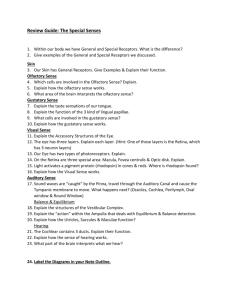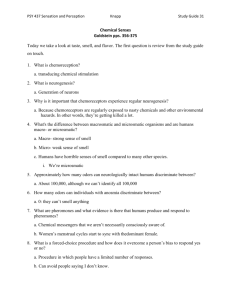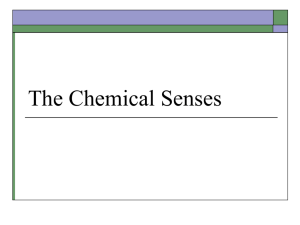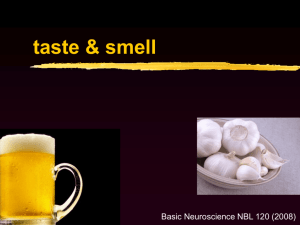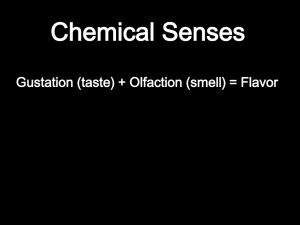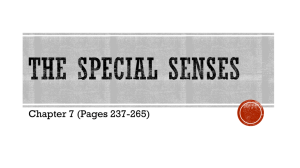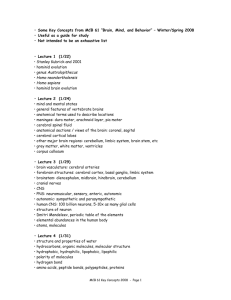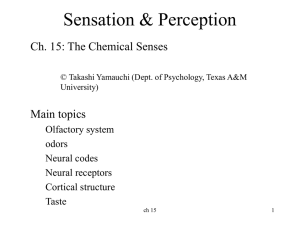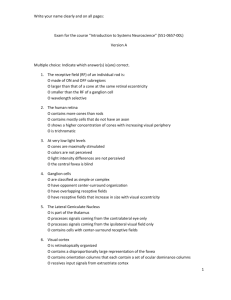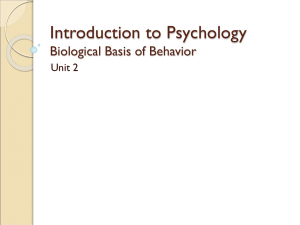Mechanisms of Perception: Hearing, Touch, Smell, Taste & Attention
advertisement
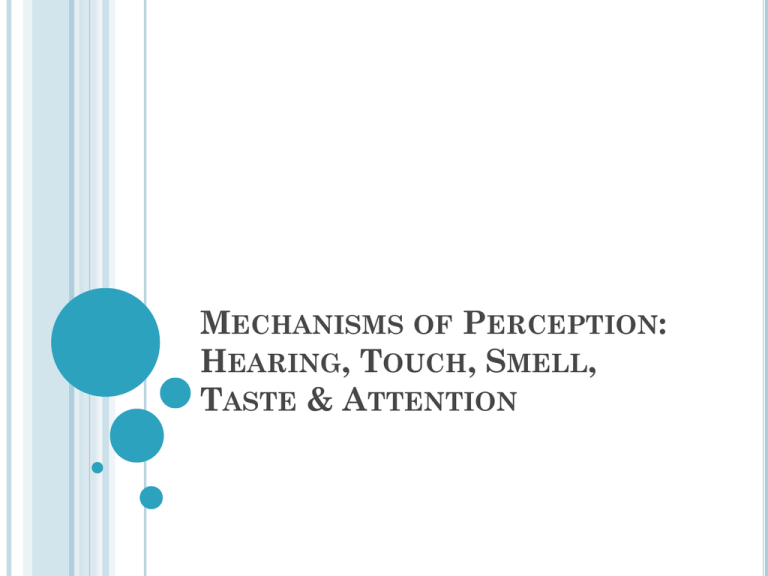
MECHANISMS OF PERCEPTION: HEARING, TOUCH, SMELL, TASTE & ATTENTION 1. 2. 3. 4. 5. 5 exteroceptive sensory systems Visual Auditory (hearing) Somatosensory (touch) Olfactory (smell) Gustatory (taste) SOMATOSENSORY SYSTEM 1. Somatosensations: sensations from your body 3 separate but interacting systems Exteroceptive system Senses external stimuli interacting with the skin 2. Proprioceptive system Monitors body position Receptors in the muscles, joints & organs of balance 3. Interoceptive system General info on the internal body conditions Ex: temp, BP EXTEROCEPTIVE SYSTEM 3 distinct divisions for perceiving different types of stimuli 1. 2. 3. Mechanical (touch) Thermal (temperature) Nociceptive (pain) CUTANEOUS RECEPTORS Receptors in the skin; many types Free nerve endings Pacinian corpuscles Largest & deepest Adapt rapidly Respond to sudden displacements of skin, not constant pressure Merkel’s disks Simplest; neuron endings with no specialized structures Sensitive to temperature change & pain Adapt slowly Respond to gradual skin indentation Ruffini endings Adapt slowly Respond to gradual skin stretch CUTANEOUS RECEPTORS When constant pressure is applied to the skin, there is a burst of firing in all of the receptors, corresponding to the sensation of touch. But after a bit, only the slowly adapting receptors stay active & the sensation changes (often becoming unnoticeable) So to maintain constant input, you move & manipulate objects in your hands Stereognosis: identification of objects by touch CUTANEOUS RECEPTORS Each type has its own unique structure, but they all basically work the same way Stimuli to the skin changes the chemistry of the receptor, which changes the permeability of the receptor cell membrane to ions, which sends a neural signal DERMATOMES Nerve fibers from cutaneous receptors come together and enter the spinal cord at the doral root The area of the body innervated by the left & right dorsal root at a given spinal segment is a dermatome 2 MAJOR SOMATOSENSORY PATHWAYS 1. Dorsal-column medial-lemniscus system 2. Anterolateral system Info about touch & proprioception Info about pain & temperature However, there is overlap in the type of info each pathway carries PG. 176 & 177 1. Dorsal-column medial-lemniscus system 2. Anterolateral system Ipsilateral, decussates at the dorsal column nuclei, contralateral Neurons of this path that start in the toes are the longest neurons in the human body! Spinothalamic tract Neurons decussate immediately upon entering the spinal cord & travel up contralaterally If both paths are cut by a spinal cord injury, there will be no sensation from below that point. CORTICAL AREAS OF SOMATOSENSATION The primary somatosensory cortex is located on the postcentral gyrus Most input is contralateral It is organized somatotopically; according to a map of the body surface Referred to as the homunculus (“little man”) *my fave!* CORTICAL AREAS OF SOMATOSENSATION Secondary somatosensory cortex is just ventral to the primary Association cortex is in the posterior parietal lobe SOMATOSENSORY AGNOSIAS Astereognosia Inability to recognize objects by touch Rare Asomatognosia Inability to recognize parts of your own body Usually only affects the left side of the body after damage to the right posterior parietal lobe PERCEPTION OF PAIN Pain is the response to any kind of harmful stimulation Serves as a warning system There is no clear cortical area involved in pain Although the anterior cingulate cortex is activated during the emotional reaction to physical pain Amazingly, we can exhibit a lot of control over our perception of pain Gate-control theory: descending cognitive signals from the brain can activate neural gate circuits in the spinal cord to block incoming pain signals DESCENDING PAIN-CONTROL CIRCUIT Activity in the periaqueductal gray has analgesic (pain blocking) effects Also has specialized receptors for opioids, including endorphins Potentially involves stimulation of serotonergic neurons NEUROPATHIC PAIN Severe chronic pain in the absence of a recognizable pain stimulus Often after an injury has healed & there should be no more reason for pain THE CHEMICAL SENSES: SMELL & TASTE These senses respond to chemicals in our environment Smell for airborne chemicals Taste for those that dissolve in our oral cavity Smell & taste are highly integrated Together they produce what we know as flavor We use these senses primarily to recognize flavor, but many other species use it for communication, via pheromones OLFACTORY SYSTEM: SMELL Receptor cells are in the upper part of your nose, within the olfactory mucosa The axons of these neurons actually project through the cribriform plate in your skull & enter the olfactory bulbs, which go via the olfactory tracts to the brain Your olfactory receptor neurons can be regenerated throughout your life Primary olfactory cortex: piriform cortex Medial temporal cortex next to the amygdala Only sensory system that does not first go through the thalamus!! GUSTATORY SYSTEM: TASTE Taste receptors are on the tongue & elsewhere in the oral cavity Occur in clusters of 50 called taste buds So each taste bud sends out many axons and many individual neural signals 1. 2. 3. 4. 5. The 5 traditional tastes Sweet Salty Sour Bitter Umami But not every taste we experience can be made from any combo of those 5… GUSTATORY PATHWAY Afferent neurons leave the mouth as the facial, glossopharyngeal & vagus cranial nerves; which terminate in the solitary nucleus of the medulla, to the ventral posterior nucleus of the thalamus, to the primary gustatory cortex Primary cortex: near the face area of the somatosensory homunculus DAMAGE TO THE CHEMICAL SENSES Anosmia: inability to smell Caused by blows to the head that rip the olfactory nerves as they pass through the cribriform plate Symptom along with several other neurological disorders Ageusia: inability to taste Rare SELECTIVE ATTENTION SELECTIVE ATTENTION At any instance, we are receiving a LOT more sensory input than we consciously perceive Selective attention is the process by which we are able to “ignore” the rest Works to essentially enhance the signals that we are focusing on & get rid of interference caused by the signals we’re ignoring Cocktail-party phenomenon Change blindness
